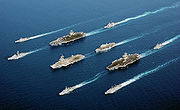
Surface warfare
Encyclopedia

Naval warfare
Naval warfare is combat in and on seas, oceans, or any other major bodies of water such as large lakes and wide rivers.-History:Mankind has fought battles on the sea for more than 3,000 years. Land warfare would seem, initially, to be irrelevant and entirely removed from warfare on the open ocean,...
is divided into three operational areas: surface warfare, air warfare and submarine warfare
Submarine warfare
Naval warfare is divided into three operational areas: surface warfare, air warfare and underwater warfare. The latter may be subdivided into submarine warfare and anti-submarine warfare as well as mine warfare and mine countermeasures...
. Each area comprises specialized platforms and strategies used to exploit tactical advantages unique and inherent to that area.
Modern surface warfare dates from the mid 20th century, when surface, air, and submarine warfare components were blended together as a tactical unit to achieve strategic objectives. The two most important strategic objectives are interdiction and sea control. Interdiction is the process of preventing enemy forces access to or through a location, for example: German naval objectives against Britain
United Kingdom
The United Kingdom of Great Britain and Northern IrelandIn the United Kingdom and Dependencies, other languages have been officially recognised as legitimate autochthonous languages under the European Charter for Regional or Minority Languages...
in World War II were primarily focused on preventing ships arriving intact with their cargos. Sea control is the dominance of force over a given area that prevents other naval forces from operating successfully, for example: the mission of the allied navies in the Atlantic during World War II was to maintain sea control and prevent Axis naval forces from operating.
In the second half of the 20th century, the importance of naval surface power was reduced as air and submarine warfare
Submarine warfare
Naval warfare is divided into three operational areas: surface warfare, air warfare and underwater warfare. The latter may be subdivided into submarine warfare and anti-submarine warfare as well as mine warfare and mine countermeasures...
platforms demonstrated their capabilities. In the 21st century, it has been clearly demonstrated that a modern navy
Navy
A navy is the branch of a nation's armed forces principally designated for naval and amphibious warfare; namely, lake- or ocean-borne combat operations and related functions...
must be composed of all three platforms (surface, submarine, and air) to be effective in projecting naval power and maintaining sea control.
When people think of naval vessels, they usually think of surface ships, such as: battleships, aircraft carriers, cruisers, destroyers, frigates, and others. Surface combatants also include mine warfare ships, amphibious command ships, coastal defense craft, amphibious assault craft, and many others. An important facet of naval warfare are the support ships: freighters, oilers, hospital ships, tugs, troop transports, and others.
See also: Naval warfare
Naval warfare
Naval warfare is combat in and on seas, oceans, or any other major bodies of water such as large lakes and wide rivers.-History:Mankind has fought battles on the sea for more than 3,000 years. Land warfare would seem, initially, to be irrelevant and entirely removed from warfare on the open ocean,...
, Modern naval tactics
Modern naval tactics
The term modern naval tactics refers to tactical doctrines developed after World War II, following the final obsolescence of the battleship and the development of long-range missiles. Since there has been no major naval conflict since World War II, with the exception of the Falklands War, many of...

